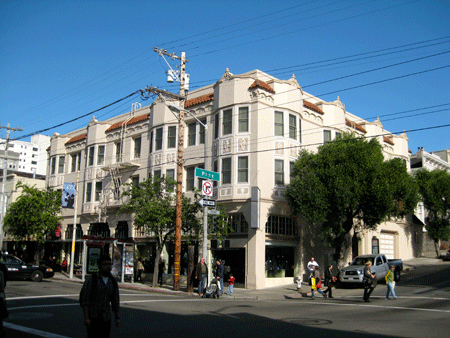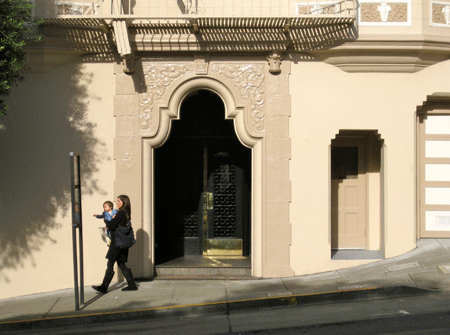
The Osada Apartments at Fillmore and Pine were built in 1928.
ARCHITECTURE | Jacquie Proctor
Soft-spoken British architect Harold G. Stoner quietly left his distinctive artistic mark on San Francisco, and one of his most important buildings stands proudly at the corner of Fillmore and Pine Streets.
The Osada Apartments — including 15 residential units and two storefronts now home to Paolo Shoes and The Grove cafe — were designed and built by Stoner in 1928.
Most of Stoner’s work was residential. He designed numerous picturesque storybook style homes in the city’s western neighborhoods. Stoner also designed a medieval mountaintop mansion for Adolph G. Sutro and the entry to the ice rink at the Sutro Baths near the Cliff House — plus Sally Rand’s Nude Ranch, the most popular exhibition at the 1939 Golden Gate International Exposition on Treasure Island.
Born in Brighton, England, in 1890, Stoner sailed to Canada to pursue a career in architecture when he turned 18. According to his daughter, Joan Stoner Crandall, he was on his way to South America in 1914 when he stopped in San Francisco. The beauty of the area persuaded him to seek fame and fortune here instead.
Initially he boarded with a family in Oakland, where he met his future wife, Jeanne Legallet, a friend of the family. The Legallets had immigrated from France, where their ancestors supplied wool and leather to Napoleon’s army for the invasion of Russia in 1812. They expanded their tannery business to San Francisco’s Butchertown a decade after the Gold Rush.
Both Stoner and his future wife served in World War I before marrying in 1920. Jeanne, fluent in French, volunteered to be a signal corps telephone operator and translator in France. Harold also went to France for the U.S. Army and saw action in three battles before gaining American citizenship at the end of the war in Marseille. Fellow veterans August and Rudy Lang gave Stoner’s career a big boost in the early 1920s when they hired him as their chief architect for the speculative houses they were building in the Forest Hill and Balboa Terrace residential areas west of Twin Peaks.
Stoner also designed a few apartment buildings. In 1928 his in-laws gave him the opportunity to create his finest multi-family building at the corner of Fillmore and Pine.
A state architectural resources survey conducted in 2007 details the ownership of the prominent corner lot. As far back as 1894, Isaac Harris owned a one-story building building at what is now 2000-2016 Fillmore that contained five shops, including a saloon and a restaurant.
Jeanne’s father, Eugene Legallet, purchased the property in 1901. Around 1920, Jeanne’s eldest sister, Blanche Sanders, purchased a two-story apartment building adjacent to the east on Pine Street. Eight years later, Blanche sold the property to their mother, Marie Legallet, and the two parcels were combined for the construction of a three-story apartment building with commercial spaces at the street level.
After Marie Legallet’s death in 1949, sisters Satomi and Kuniye Koga purchased the property from her estate for $75,000. It was soon resold to Joe and Amy Osada, whose descendents still own it.
The historical survey of the property enumerated its architectural details, concluding: “The building retains a high level of integrity of design, materials, workmanship and feeling, since few major alterations have been made.”

The entry to the Osada Apartments at 2280 Pine Street shows the architect's artistic flair.
But its cultural significance, the report said, was its role in the development of the Japantown community after the return of Japanese-Americans to the city from forcible internment during World War II. “The change in property ownership to the Osadas, through the Kogas, reflects patterns of postwar resettlement as Japanese-Americans sought to reestablish themselves and their community,” the report notes.
“The fact that the property’s first Japanese American owners were American-born … is indicative of historic difficulties faced by Japanese, who were not able to own property due to laws like the Webb-Heney Alien Land Act, which was in effect from 1913 to 1956 and made it illegal for ‘aliens ineligible for citizenship’ to own property.”
The building is a rare surviving example of Harold Stoner’s multi-family architecture. The Osada’s son Bill has meticulously maintained the Mediterranean Revival ornamentation that distinguishes the building as among Stoner’s best architectural work.
It includes his signature spindled window mullions and the sculpted coat of arms motif below each of the angled bay windows, which have been accentuated by a recent repainting. Clerestory stained glass windows divided by pillars with scalloped tops welcome customers to the two commercial storefronts, which for more than two decades were occupied by the Brown Bag and the Chestnut Cafe. In earlier years the storefronts housed a furniture store, a real estate office and an insurance company. The facade of the building terminates in a parapet adorned with green diamond tiles framed by curved moldings and a red clay barrel tile roof.
The recessed entrance to the apartments around the corner at 2280 Pine Street is decorated with one of Stoner’s signature arches, elaborate sculpted moldings and ornate grillwork. Through the lobby’s plate glass doors is a visual delight of colorful tiled steps, hand-crafted wrought iron sconces, stenciled beams and a tiled fountain — another Stoner trademark — bringing a bit of Mediterranean warmth indoors.
By the end of his career, Stoner had designed more than 500 homes and other buildings known for their livability, charm and artistic detail. His work included commissions in Sea Cliff, St. Francis Wood and other western neighborhoods, plus homes and buildings in Marin County, the Peninsula and the East Bay and as far away as Lake Tahoe and Los Angeles. He died in 1971 and is buried in the Golden Gate National Cemetery.
Jacquie Proctor is the author of Bay Area Beauty: The Artistry of Harold G. Stoner, Architect.
Filed under: Art & Design, Home & Garden, Landmarks, Neighborhood History





